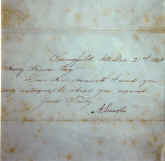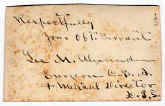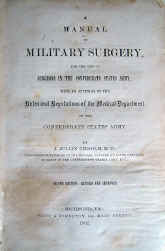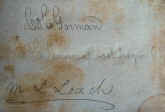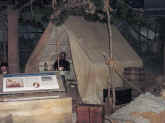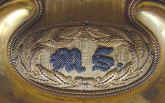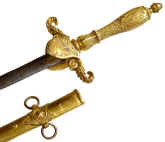| President-Elect Abraham Lincoln, while still in Springfield, Illinois, answers a request for his autograph from Henry Faxon, a New York journalist, 21 December 1860. The body of the document is in the hand of Elmer Ellsworth, Lincoln's law clerk. In this document, one finds the hands of the first and last heroic martyrs of the Civil War. Lincoln's autograph is bold and strong. SOLD | |
| A fine model 1850 foot officer's sword with ricasso marked: P.D.L within an oval, indicating that the blade was made by P.D. Luneschloss and sold through Tiffany's, New York. The pristine blade is beautifully etched and frosty. According to an old tag, the belonged to Lt. William H. Hildreth, 2nd Co. Cadets, Massachusetts Volunteer Militia and the Massachusetts Volunteer Infantry. SOLD
|
|
| A pair of Civil War cartes-de-visite of District Indian Territory Confederate surgeons, both with tinted emerald green sashes. Note the ivory-handled surgical set on the table. (An example of the Parker amputation saw shown in the surgical set is illustrated here.) The surgeon is holding an amputation knife. These images are thought to be the finest CDVs of Confederate surgeons. SOLD | 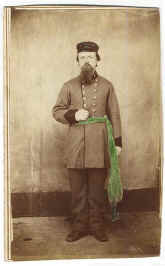
|
| J. Julian Chisolm, M.D., A Manual of Military Surgery for the Use of Surgeons in the Confederate States Army. Richmond: West & Johnston, 1862. Second edition. The covers and spine are original and show wear consistent with use in the field. The front flyleaf is signed in pencil: C.H. Gorman / Assistant Surgeon C.S. and, in a second hand, M.L. Leach. The rear flyleaf has a decayed ink inscription that reads: 30th Regt. / AL Vols. / July / 1862. Dr. Claiburn H[arrison?] Gorman was mustered at Talladega into the 30th Alabama Infantry on 31 March 1862. He graduated from the Medical College of Georgia, Augusta, in 1854, and lived in Alpine, Alabama. Dr. Morgan L. Leach served as an assistant surgeon in the 9th Michigan Cavalry and was from Du Plain, Michigan. The two respective regiments had been in proximity to one another often in the Civil War campaigns from Chattanooga to Bentonville, and Leach may have acquired the manual around the time of the surrender of the Army of the Tennessee at Greensboro, North Carolina, on 26 April 1865. SOLD |
|
|
The only known surviving example of a Civil War U.S. Army officer's wall tent. It is 9 feet high, 9 feet long, and 15 feet wide. The poles are original. The tent belonged to Surgeon John Wiley of the 6th New Jersey Volunteer Infantry. The 6th took part in many of the major battles of the East, including the Peninsula Campaign, Bull Run, Fredericksburg, Chancellorsville, Gettysburg, Spotsylvania, Cold Harbor, and Petersburg, to mention a few. For a history of the 6th New Jersey, please click here. The tent has been in the collection of the noted Civil War medical historian Dr. Gordon Dammann, and it is featured in two of his books on Civil War medical antiques. It remained in the estate of Dr. Wiley, of Cape May , New Jersey, until 1988, when I originally sold it to Dr. Dammann. The tent is presently on display at the National Museum of Civil War Medicine, Frederick, Maryland. SOLD
A fine pair of Civil War date regulation Medical Staff epaulettes with applied oak leaves to indicate the rank of major (full surgeon). The gold finish to the crescents and the two embroidered pillows with old English M.S. letters within the wreaths are superb. The brass fastening clips of each are marked: HORSTMANN BROTHERS & ALLIEN / NEW YORK. The company is a well-known Civil War outfitter.
|
|
|
A scarce and superb Model 1840 Medical Staff sword by N. P. Ames. Old English silver M.S. letters are applied to the shield of the hilt. One side of the blade is etched with a caduceus and the legend: U.S. Medical Staff. The other side displays an eagle and panoply. The blade is further steel point engraved at the ricasso: N.P. Ames / Cutler / Springfield. The throat of the scabbard is engraved: N.P. AMES / Cutler / Cabotville / MASS. As Nathan Peabody Ames died in 1847, and the company subsequently changed its name, this sword was made between c. 1840-1847. The sword is very well-made, and the casting, chasing, and etching are of a higher standard than the Civil War period Ames Model 1840 production (which was still considered a superior sword at the time). Some 99% of the original gilt finish is present, and the blade retains its original bright polish. |
|
|
A fine original albumen photograph of Generals George Armstrong Custer and Alfred Pleasonton at Warrenton, VA, 1863. SOLD |
 |
|
A high quality regulation Model 1850 Staff and Field officer's sword from Lambert & Mast, Philadelphia. Attached to the scabbard is a brass plaque that is inscribed: Presented to / Col. Wm. Frishmuth / of the 12th Regt. Penna. Cavalry / By the / Officers of the Regiment / March 13 1862. The sword is in fine original condition throughout, including the well-etched blade. William Frishmuth owned the Frishmuth Foundry in Philadelphia, and he was the only aluminum producer in the United States for many years. Frishmuth was responsible for making the Washington Monument's aluminum pyramid cap, considered a major technological achievement in its day. SOLD
|
